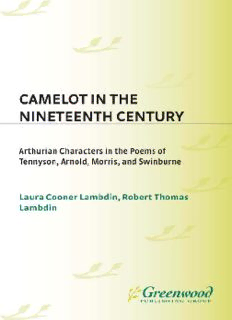
Camelot in the Nineteenth Century: Arthurian Characters in the Poems of Tennyson, Arnold, Morris, and Swinburne (Contributions to the Study of World Literature) PDF
Preview Camelot in the Nineteenth Century: Arthurian Characters in the Poems of Tennyson, Arnold, Morris, and Swinburne (Contributions to the Study of World Literature)
Camelot in the Nineteenth Century Recent Titles in Contributions to the Study of World Literature The Adventure of the Detected Detective: Sherlock Holmes in James Joyce's Finnegans Wake William D. Jenkins Afro-Cuban Literature: Critical Junctures Edward J. Mullen The Tales We Tell: Perspectives on the Short Story Barbara Lounsberry, Susan Lohafer, Mary Rohrberger, Stephen Pett, and R. C. Feddersen, editors Robin Hood: The Shaping of the Legend Jeffrey L. Singman The Myth of Medea and the Murder of Children Lillian Corti African-British Writings in the Eighteenth Century: The Politics of Race and Reason Helena Woodard Styles of Ruin: Joseph Brodsky and the Postmodernist Elegy David Rigsbee The Image of Manhood in Early Modern Literature: Viewing the Male Andrew P. Williams, editor The Worlding of Jean Rhys Sue Thomas Ulysses, Capitalism, and Colonialism M. Keith Booker Imperial Knowledge: Russian Literature and Colonialism Ewa M. Thompson Demythologizing the Romance of Conquest Jeanne Armstrong Camelot in the Nineteenth Century Arthurian Characters in the Poems of Tennyson, Arnold, Morris, and Swinburne Laura Cooner Lambdin and Robert Thomas Lambdin Contributions to the Study of World Literature, Number 97 GREENWOOD PRESS Westport, Connecticut • London Library of Congress Cataloging-in-Publication Data Lambdin, Laura Cooner. Camelot in the nineteenth century : Arthurian characters in the poems of Tennyson, Arnold, Morris, and Swinburne / Laura Cooner Lambdin and Robert Thomas Lambdin. p. cm.—(Contributions to the study of world literature, ISSN 0738-9345; no. 97) Includes bibliographical references and index. ISBN 0-313-31124-2 (alk. paper) 1. English poetry—19th century—History and criticism. 2. Arthurian romances—Adaptations—History and criticism. 3. Tennyson, Alfred Tennyson, Baron, 1809-1892—Knowledge—Arthurian romances. 4. Swinburne, Algernon Charles, 1837-1909—Knowledge— Arthurian romances. 5. Arnold Matthew, 1822-1888—Knowledge— Arthurian romances. 6. Morris, William, 1834-1896—Knowledge— Arthurian romances. 7. Medievalism—England—History—19th century. 8. Knights and knighthood in literature. 9. Kings and rulers in literature. 10. Middle Ages in literature. 11. Camelot (Legendary place) I. Lambdin, Robert Thomas. II. Title. III. Series. PR595.A79L36 2000 821'.809351—dc21 99-21707 British Library Cataloguing in Publication Data is available. Copyright © 2000 by Laura Cooner Lambdin and Robert Thomas Lambdin All rights reserved. No portion of this book may be reproduced, by any process or technique, without the express written consent of the publisher. Library of Congress Catalog Card Number: 99-21707 ISBN: 0-313-31124-2 ISSN: 0738-9345 First published in 2000 Greenwood Press, 88 Post RoadWest, Westport, CT 06881 An imprint of Greenwood Publishing Group, Inc. www.greenwood.com Printed in the United States of America The paper used in this book complies with the Permanent Paper Standard issued by the National Information Standards Organization (Z39.48-1984). 10 9 8 7 6 5 4 32 To Our Sweet Siblings Jef Debbi, Marion, and John This page intentionally left blank Contents Introduction ix 1. Arthurian Legends: Origins to the Nineteenth Century 1 2. Alfred Tennyson 13 3. Matthew Arnold 51 4. William Morris 71 5. Algernon Swinburne 107 6. Final Remarks 143 Selected Bibliography 147 Index 155 This page intentionally left blank Introduction For centuries, accounts of King Arthur and his court have fascinated historians, scholars, poets, and readers. Legends of this powerful, commanding warrior, who was also the perfect monarch of tragic destiny, probably began as folk stories in Wales and Ireland. The Arthurian story remains with us because it has always been "common property, with no copyright and no prize for originality. Every author is an independent agent, but cannot work without his predecessors: he is a dwarf standing on the shoulders of a cumulative giant" (R. Morris 4). Each age added aspects that reflected its own cultural attitudes; however, no age supplemented the earlier versions more than the poets writing during the Medieval Revival of nineteenth-century England, a revival that embraced art, architecture, philosophy, economics, politics, sociology, and religion. The Medieval Revival had its origins in the Romantic movement's susceptibility to the beauty and intensity of medieval literature. Before this, between the Middle Ages and the rise of Romanticism, the classical spirit ruled and was by nature alien to medievalism. The French Revolution brought rapid and frightening changes that conservative England wished to avoid. Post-Napoleonic attitudes toward the Middle Ages began with ideas of a charming, picturesque period stemming from Sir Walter Scott's preoccupation with the period's romantic and historical
